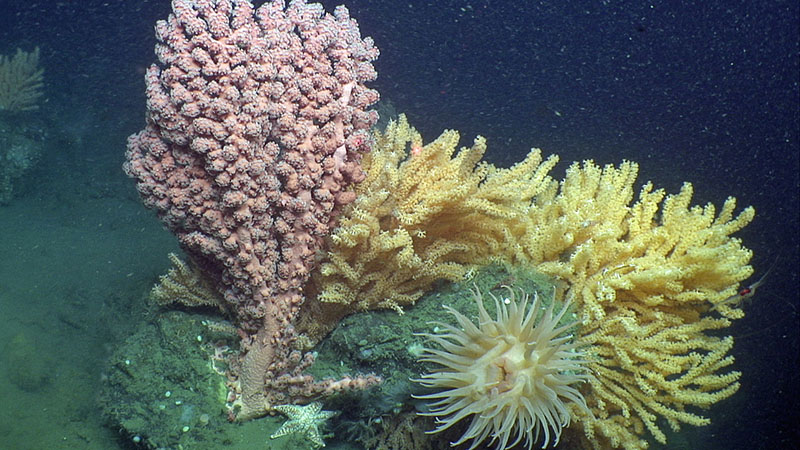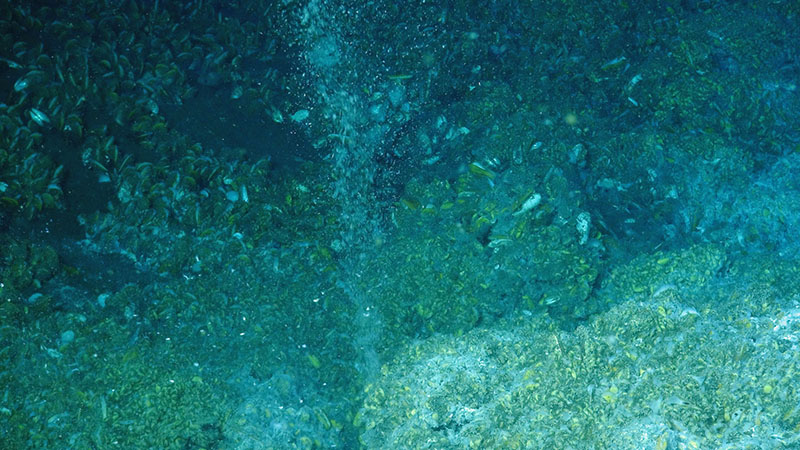
By Caitlin Adams, NOAA Office of Exploration and Research

During the previous BOEM-USGS-NOAA Atlantic study, researchers explored coral habitats like this one, where a red bubblegum coral (Paragorgia) and several colonies of Primnoa occupy a boulder in close proximity to an anemone and sea star, at ~440 meters in Norfolk Canyon. Image courtesy of Deepwater Canyons 2013 - Pathways to the Abyss, NOAA-OER/BOEM/USGS. Download larger version (jpg, 1.2 MB).
Though this is its first expedition, DEEP Sea Exploration to Advance Research on Coral/Canyon/Cold seep Habitats (DEEP SEARCH) has been in the making for over two years now—and has been a goal for far longer than that. Representatives from the Bureau of Ocean Energy Management (BOEM), the U.S. Geological Survey (USGS), and NOAA Office of Ocean Exploration and Research have been busy working behind the scenes to identify resources, align research interests, and successfully launch this multi-agency, multi-year study since the beginning of 2016.
DEEP SEARCH is born from a long and successful tradition of BOEM-USGS-NOAA projects sponsored through the National Oceanographic Partnership Program (NOPP), a Congressionally mandated program dedicated to facilitating ocean research partnerships across the federal agencies.
The NOPP encourages federal agencies to pool their resources and talents, envisioning projects that would otherwise be beyond the scope of any single agency. With DEEP SEARCH, each agency has contributed crucial pieces of the puzzle: BOEM initiated the work through its studies development plan and contracted TDI-Brooks International, Inc. through a competitive award process to conduct the research; USGS identified five complementary research areas and will be supporting the participation of corresponding science teams on each expedition and contributing to the final study report; NOAA OER will provide the assets (ship, autonomous underwater vehicle or remotely operated vehicle) for each research cruise, as well as the necessary expedition coordination, data management, and engagement support for each of those field efforts.
Our work on NOAA Ship Pisces is just the first year of DEEP SEARCH. Two future cruises are planned in 2018 and 2019. Next year, the team will be out on NOAA Ship Nancy Foster for its first remotely operated vehicle sampling cruise. In 2019, we will likely have the opportunity to sail on NOAA’s flagship vessel, the Ronald H. Brown.

Methane gas bubbles rise from the seafloor—this type of activity, originally noticed by NOAA Ship Okeanos Explorer in 2012 on a multibeam sonar survey, is what led scientists to the area. Image courtesy of Deepwater Canyons 2013 - Pathways to the Abyss, NOAA-OER/BOEM/USGS. Download larger version (jpg, 890 KB).
Each year, scientists will be collecting data to better understand the functional role of submarine canyons, hydrocarbon seeps, and coral habitats. These hardbottom habitats add considerable environmental complexity to the seafloor and influence the distribution and abundance of deep-sea organisms, including many commercially important species. This increased knowledge will improve our ability to predict sensitive areas of the deep sea and inform future management decisions in the region.
TDI-Brooks International has assembled a team of researchers that span across disciplines and across the country, with lead scientists from six U.S. institutions: Temple University, University of New Hampshire, Nova Southeastern University, University of Georgia, Florida State University, and Harvey Mudd College. The collaboration extends beyond national borders though as well—researchers from the Royal Netherlands Institute of Sea Research (NIOZ) will be contributing scientists and long-term monitoring equipment to the project and linkages to the European Union’s Horizon 2020 ATLAS project are planned.
Finally, DEEP SEARCH will play a significant role in ongoing and future work planned in the mid- and South Atlantic. Representatives from USGS, BOEM, OER, and other NOAA offices are in regular conversation to coordinate South Atlantic field efforts. Therefore, while DEEP SEARCH is itself a large, integrative study, it is one component of an even larger cross-Atlantic basin effort associated with the Atlantic Seafloor Partnership for Integrated Research and Exploration (ASPIRE) campaign.